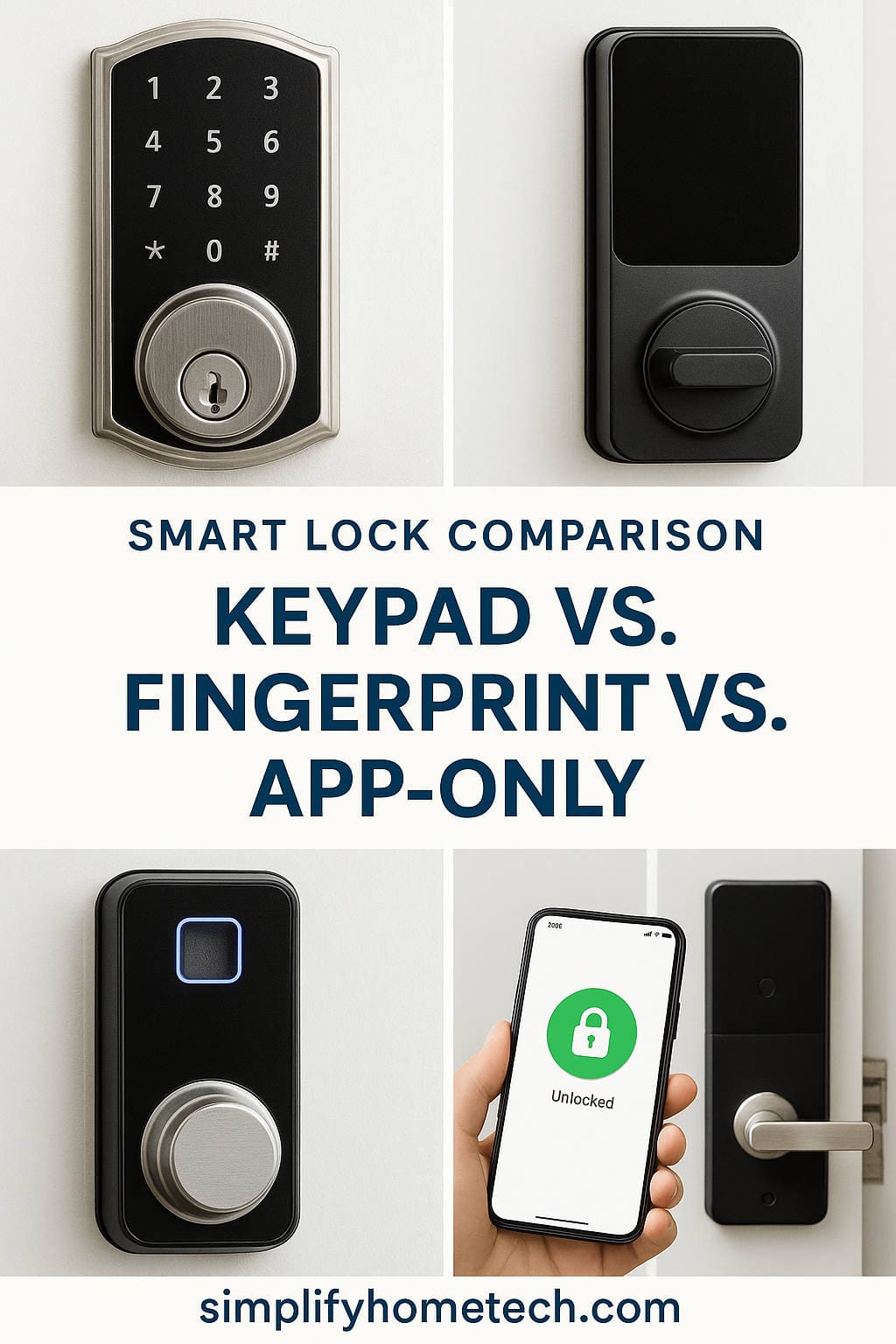In today’s connected world, home security is getting a major upgrade. Traditional deadbolts are giving way to smart locks, which offer enhanced convenience, better control, and smarter ways to keep your home safe. With multiple types of smart locks available, it can be tough to decide which one is right for you.
Three of the most popular smart lock types are:
- Keypad Locks
- Fingerprint (Biometric) Locks
- App-Only Locks
Each has its unique advantages and disadvantages, depending on your lifestyle, security concerns, and comfort with technology. This comprehensive guide will help you understand the strengths and weaknesses of each option so you can make an informed decision.
What Are Smart Locks?
Smart locks are electronic locking systems that allow you to control access to your home without using traditional metal keys. Instead, they use digital authentication methods like passcodes, biometric identification, or smartphone apps. Many smart locks also provide advanced features like activity logs, temporary guest access, and integration with home automation systems.
Now let’s explore and compare each of the three types in depth.
Keypad Locks: Simple, Reliable, and Budget-Friendly
How They Work
Keypad locks allow access through a numeric code. Users enter a personal identification number (PIN) on a touchscreen or physical keypad to unlock the door. Most models support multiple user codes and allow temporary or one-time access codes.
Advantages
- User-Friendly: No need to carry keys or smartphones. Just punch in your code.
- Customizable Access: Great for households with kids, guests, or housekeepers.
- Affordable: Typically the least expensive type of smart lock.
- Easy to Install: Most models fit standard deadbolt mounts and are DIY-friendly.
- Reliable: Works independently of Wi-Fi or mobile signals.
Disadvantages
- Security Concerns: Finger smudges or worn-out buttons can reveal commonly used digits.
- No Remote Access: Unless paired with a smart hub, you can’t unlock the door remotely.
- Limited Smart Features: May not offer integrations with smart home ecosystems.
Best For
- Families with children or elderly members
- Short-term rental properties like Airbnb
- People who prefer a low-tech yet effective solution
Fingerprint Locks: High-Security, Touch-Based Access
How They Work
Fingerprint locks, also known as biometric locks, scan and recognize your fingerprint to grant access. These locks store authorized fingerprints in their memory and compare each scan against that database.
Advantages
- Highly Secure: Each fingerprint is unique, making unauthorized access very difficult.
- Fast and Convenient: No need to remember codes or carry anything.
- User Management: Most models can store multiple fingerprints and allow quick removal or addition of users.
- Modern Aesthetic: Sleek and futuristic look that blends well with contemporary homes.
Disadvantages
- Higher Cost: Biometric technology adds to the price.
- Environmental Sensitivity: Dirt, water, or extreme temperatures can affect sensor performance.
- Technology Limitations: Some cheaper models may have poor accuracy or slow response times.
Best For
- Tech-savvy homeowners who prioritize security
- Offices or secure areas needing controlled access
- Homes in gated communities or neighborhoods with higher security expectations
App-Only Locks: Full Control at Your Fingertips
How They Work
App-only smart locks rely entirely on a mobile app, connected via Bluetooth or Wi-Fi, to lock and unlock your door. Some also support voice assistants like Alexa, Google Assistant, or Siri.
Advantages
- Remote Access: Control your door from anywhere in the world.
- Real-Time Monitoring: See who accessed the lock and when.
- Custom Alerts: Get notified about suspicious activity or when someone enters/exits.
- Smart Home Integration: Works well with smart hubs and devices.
- Temporary Access: Share digital keys with guests or service providers.
Disadvantages
- Smartphone Dependency: If your phone dies or gets lost, access could be difficult.
- Internet Reliant: May fail without Wi-Fi or mobile data.
- Higher Learning Curve: Requires setup, app downloads, and occasional firmware updates.
- Privacy Risks: If not properly secured, your lock could be vulnerable to hacking.
Best For
- Frequent travelers
- Landlords or property managers
- Homeowners with existing smart home ecosystems
Security Breakdown
Keypad Locks
Security largely depends on your code practices. Regularly changing your PIN and using unique number combinations can mitigate risks. Some locks offer features like auto-locking or tamper alarms for added safety.
Fingerprint Locks
Biometric access is incredibly secure, as it relies on something you are rather than something you know. However, choose models with strong encryption and spoof-prevention technologies.
App-Only Locks
These provide the most flexible and detailed access control. From two-factor authentication to encrypted communication, high-end models can be very secure. Still, they’re only as safe as your smartphone and internet security.
Verdict: For physical access security, fingerprint locks come out on top. For digital security and control, app-only locks are the leaders.
Installation and Setup Comparison
Keypad Locks
Most keypad locks are easy to install and replace traditional deadbolts. They usually require a screwdriver and a few minutes of time.
Fingerprint Locks
Installation is similar to keypad locks but may include additional steps for aligning and testing the fingerprint sensor. Professional installation can ensure accuracy and functionality.
App-Only Locks
These often need syncing with Wi-Fi or Bluetooth and require account setup through a mobile app. Some may also need a smart hub, adding to the complexity.
Verdict: Keypad locks win in terms of straightforward installation.
Maintenance and Reliability
Keypad Locks
Minimal upkeep. Just change the batteries every 6-12 months. Some models come with a mechanical key override.
Fingerprint Locks
Sensors may require regular cleaning for optimal performance. Battery life varies but typically lasts several months. Ensure the lock performs well under varying temperatures.
App-Only Locks
Requires periodic software updates, a reliable internet connection, and battery checks. Expect occasional troubleshooting with connectivity or app glitches.
Verdict: Keypad locks require the least maintenance.
Cost Considerations
| Lock Type | Price Range | Additional Costs |
|---|---|---|
| Keypad | $50 – $150 | Minimal |
| Fingerprint | $100 – $300 | Optional professional install |
| App-Only | $100 – $400 | May need smart hub, subscription |
Keypad locks are the most budget-friendly, while fingerprint and app-only locks are on the higher end due to advanced technology and features.
Smart Home Integration
Keypad Locks
Some models offer limited integration with platforms like Alexa or Google Assistant, especially if bundled with a smart hub.
Fingerprint Locks
Integration varies by brand. Some offer voice assistant compatibility and work with platforms like Samsung SmartThings.
App-Only Locks
Most are designed with smart home users in mind. Expect full support for IFTTT, Apple HomeKit, voice control, and automation routines.
Verdict: App-only locks lead in smart home integration.
Use Case Scenarios
1. Families With Kids
Best Option: Keypad Lock. Easy for kids to use without needing a phone or key.
2. Tech Enthusiasts
Best Option: App-Only Lock. Integration with voice control, remote access, and automation makes this ideal.
3. High-Security Needs
Best Option: Fingerprint Lock. Biometrics provide the highest physical access control.
4. Rental Property Owners
Best Option: Keypad or App-Only Lock. Grant and revoke access codes or digital keys as needed.
5. Seniors or Less Tech-Savvy Users
Best Option: Keypad Lock. Simple to use and reliable.
Pros and Cons Summary
| Lock Type | Pros | Cons |
|---|---|---|
| Keypad | Easy to use, affordable, no keys required | Limited remote control, potential for code guessing |
| Fingerprint | Secure, no code or key needed, quick access | Higher cost, can be unreliable in certain environments |
| App-Only | Remote control, access logs, smart home integration | Depends on internet and phone, higher learning curve |
Hybrid Smart Locks: The Best of All Worlds
If you’re torn between options, consider hybrid models that combine features. Some locks offer:
- Keypad + App
- Fingerprint + Keypad
- Fingerprint + App
These give you the flexibility to use whatever method suits you in the moment — whether that’s unlocking via app when you’re out of town, using a fingerprint when your hands are full, or giving a code to a visiting relative.
While they tend to be more expensive, hybrid locks offer versatility and peace of mind by ensuring you’re never locked out due to a dead phone or forgotten code.
Final Thoughts
Choosing the right smart lock boils down to your individual needs, home setup, and how much you’re willing to invest in convenience and security.
- Go with a Keypad Lock if you want a simple, affordable, and user-friendly solution.
- Opt for a Fingerprint Lock if top-notch physical security and ease of use matter most.
- Choose an App-Only Lock if you’re looking for remote access, smart home integration, and feature-rich control.
For many homeowners, a hybrid smart lock that blends multiple technologies may offer the best value and peace of mind.
No matter which option you choose, upgrading to a smart lock is a step toward a smarter, safer, and more convenient lifestyle. Just remember to evaluate your priorities and do your research before making a final decision.
Ready to upgrade your home security? Consider your daily routine, tech comfort level, and the specific features that matter most. Whether it’s for a busy household, a rental property, or a high-security home, there’s a smart lock out there tailored just for you.
You might also like,

